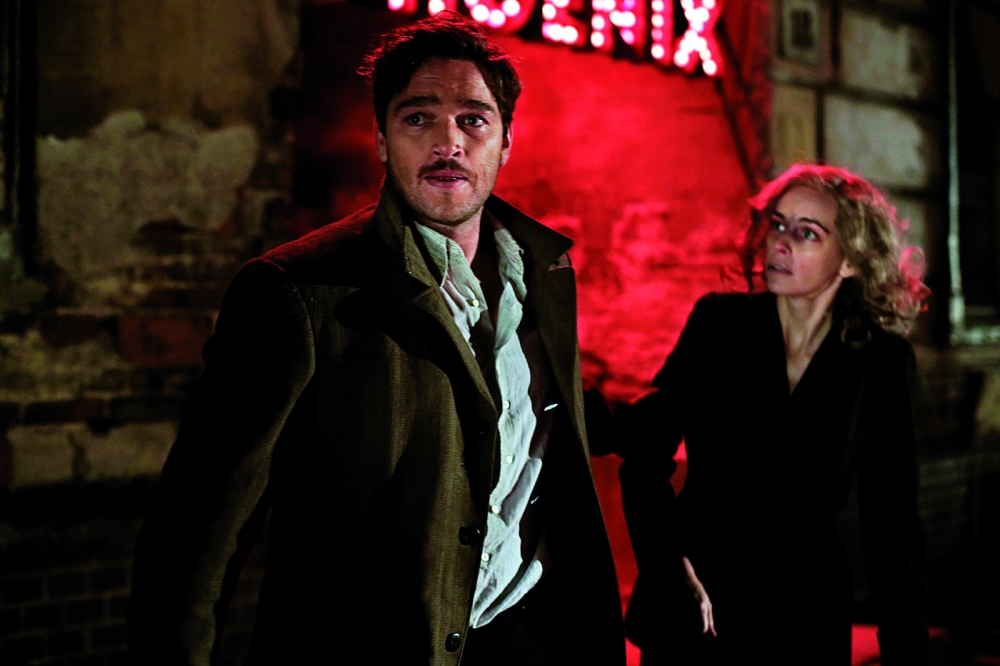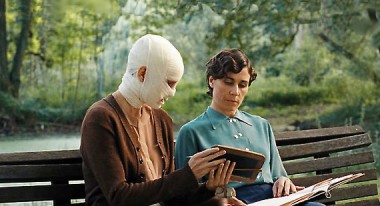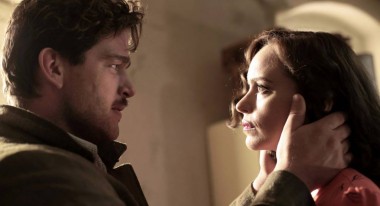 Back to selection
Back to selection
Fabricated: Petzold’s Astounding Phoenix
 Ronald Zehrfeld and Nina Hoss in Phoenix
Ronald Zehrfeld and Nina Hoss in Phoenix Still bearing facial scars from vain attempts to kill her in a concentration camp, the festering infection that followed, and drastic plastic surgery to re-create her (the doctor’s term) in a hospital in her bombed-out hometown of Berlin, the once ravishing Jewish chanteuse Nelly Lenz (Nina Hoss) recklessly saunters out alone into the night to search for the Aryan pianist husband she has not seen since her arrest. Extremely self-conscious, she asks a blind street musician where to even begin looking. Pointedly, he recommends the American sector: That’s where the clubs and the action are.
The film’s title is the name of the G.I. hangout she explores. Without a hint of subtlety, it references the archetypal emergence from the ashes — but by whom? Nelly? Her spouse? The remaining Jews? The defeated German Volk?
Director Christian Petzold (Barbara, Yella, Jerichow) does not isolate any one of these questions from the others. His films do not divorce personal drama from underlying historical, social, and/or economic forces. He has spoken about what he calls the aftershocks of the past in the present in some of his earlier work. In The State I Am In (2000), for example, an expat family of former terrorists living underground returns to a Germany greatly altered, one they no longer recognize: They have become dated.
The almost obscenely gorgeous Phoenix affords him the opportunity to take on the aftermath of an indescribably horrible German epoch that had only just ended, and against that backdrop to construct an intimate narrative around a small circle of acquaintances who managed somehow to survive. He succeeds on both counts. Ingeniously, he does so without trivializing the Shoah, unlike the majority of films that address or circle around it.
The postwar presence of young, unworldly U.S. soldiers adds yet another layer to the increasing seepage of American pop culture into the crevices of a stuffier, more rigid German social order. It’s no surprise that the signature musical number Nelly watches from a dark section of the Phoenix is a lowbrow song-and-dance rendition of Cole Porter’s “Night and Day,” or that the melancholy chilling jazz standard “Speak Low” plays an important role in defusing the cumulative tension of the plot. (Kurt Weill composed the music for a Broadway show after he immigrated to the States; American poet Ogden Nash wrote the lyrics.) In fact, we shall see that the entire film foregrounds performance.
Speak low when you speak, love,
Our summer day withers away
Too soon, too soon….
Our moment is swift, like ships adrift,
We’re swept apart too soon.
We witness the American infiltration in the very first scene, when Nelly, her head swathed in bandages, arrives at the German border from Switzerland with her close friend, no-nonsense lawyer Lene (Nina Kunzendorf, exceptional). A brash young soldier from the occupying U.S. army gives the women a hard time, brusquely waving aside Lene’s diplomatic plea not to make Nelly reveal her literally war-torn face. His muttered apology cannot mask his innate vulgarity. He is the complete opposite of the refined, controlled woman who had tried to reason with him.

This is not a judgment of the unsophisticated young fellow, considering that the Germans had just systematically murdered millions of civilians. It is merely an observation of cultural difference and the prominent placement Petzold gives the encounter. Soon afterward, Nelly undergoes a complicated operation, one which makes her look similar to, but not exactly like, the way she appeared before being sent to the camp. The result is a mix of the prewar Nelly and an imprecise replicant — attractive but counterfeit.
The stage is now set for the after-the-fact input of Hollywood, during and immediately after World War II home of last resort for many of Germany’s great directors. Many of them had been practitioners of German Expressionism, which they modified in their new country into the patently American genre of film noir. Its moody compositions run throughout Phoenix, but another studio style also comes into play: the Technicolor drama, most notably the psychological thriller. Hans Fromm does a beautiful job of widescreen cinematography, capturing the shadows and silhouettes of noir but diluting their harshness with richly saturated scenes of a more inviting natural world.
Nelly finds her husband, handsome, virile Johnny Lenz (an excellent Ronald Zehrfeld), working at the Phoenix but hardly tickling the ivories: He is a bus boy. He doesn’t recognize his re-sculpted wife, sensing only a faint resemblance. It’s enough, however. Lusting after her inheritance as the sole family survivor rather than the woman herself, he engages her to impersonate his wife — to play the part of…herself!
Ignoring signs of his disinterest and, even worse, well-sourced information that he had betrayed her to the Nazis to avoid imprisonment, Nelly complies. He still gets under her skin. In the delusional hope that everything will be as it once was, she calls herself Esther, the name of a close friend who died in the camp. Lene, the moral barometer of the film who tirelessly documents which Jews survived for purposes of reparation, has no patience for such schoolgirlish behavior. In her view, the survivors have obligations to those who perished; fantasy flirtations with traitors is not among them. A space no longer exists for individual actualization; the collective takes precedence. She wrongly assumes that Nelly will forego the unproductive pursuit of unrequited love and accompany her to Palestine to help build a state where Jews don’t have to fear a reprisal of what they have just been through.

Gradually, Esther looks and behaves more and more like Nelly, so much so that Johnny sometimes slips and responds to her as if she were. Of course! This is the scenario of Paramount’s Vertigo. Hitchcock had long been in the U.S. by then, not to mention that the screenplay, adapted from a French novel, was written by Australian-born Alec Coppel, who worked in London and Hollywood, and the American Samuel A. Taylor. Petzold also borrows from two novels set during and just after the Holocaust: Return From the Ashes, by French writer Hubert Monteilhet; and German author/director Alexander Kluge’s An Experiment in Love.
In Vertigo, James Stewart’s character, also called John, aka Scottie, may be a wooden aw-shucks detective, but Phoenix’s Johnny (real name: Johannes) is complex, a Svengali with strong animal magnetism and the determination to make it through these days of rubble and poverty. When necessary, however, Nelly takes the upper hand. The odd relationship, which you buy into following a few moments of incredulity, evolves within a particular historical and economic context. America provides the pulp, the German worldview elevates it to a more heady dimension.
Even the nickname “Johnny” is unapologetically ripped from American genre films. Petzold almost always develops the idea for a project (often taken from the non-fiction work of his mentor and close friend, the late Harun Farocki) inside a generic template. The ardent cinephile has modeled films on Detour, Carnival of Souls, The Postman Always Rings Twice, Halloween, After Dark, Running on Empty, and The 39 Steps, among other English-language titles.
Petzold is obsessed with transformation, which usually takes place at the intersection of employment and affairs of the heart. (Fassbinder is a major influence.) A change of location is frequently a factor as well. In Phoenix, he raises these themes to a whole other plane. The change is a reconfiguration; the site, the human body. Nelly would have the same revised visage anywhere she moved to. Work? Not a player here. She is still healing, the unemployment rate in Germany is sky-high, and she has that inheritance coming.

Before her surgery, the doctor had tried to encourage her: “A different face offers you a chance to reinvent yourself.” She vehemently disagreed, insisting that he carve her into the woman she had been. She had not thought things out. When Johnny orders her to wear a nice red dress for her staged arrival by train back home from the camp, she does not consider how such a lovely appearance encourages ordinary Germans to evade the issue of culpability. (Denial is the norm for almost everyone. It begins with Johnny, who tellingly does not meet her gaze. He refuses to absorb telling signs that Esther and Nelly are one and the same.) By the time she comprehends the worth of the surgeon’s advice, she has portrayed both Nelly and Esther, contingent on situation and observer. Ambiguity in later scenes, however, poignantly points to the possibility of a major self-makeover.
Hoss, the director’s longtime muse and one of the finest actors working in cinema today, effectively uses her eyes, mouth, hands, torso, posture, and movements to differentiate the two, to convey not only each of them separately, but also the transitional phases that are part Nelly, part Esther. On the surface, Nelly appears more or less the way she did before the war. On the other hand, the indignities and frustration she has endured, the grief she has suffered, and the misanthropy she has witnessed time and again have left indelible scars that no medical procedure can mend.
